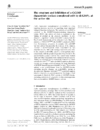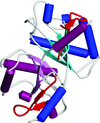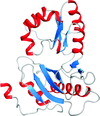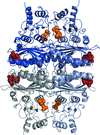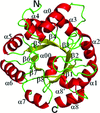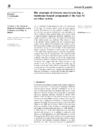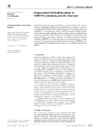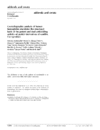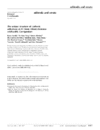issue contents
December 2011 issue

Cover illustration: The two-dimensional organization of Zn2+-cross-linked human transthyretin L55P dimers as observed from the crystal packing (p. 1035). The Zn2+-binding sites are highlighted and also the other residues from crystal-contact interactions, namely His56, Ala37 and Asp39. Dimers lying on different sides of this bilayer-like assembly are coloured differently. In this arrangement, the ![[beta]](/logos/entities/beta_rmgif.gif) -strands from symmetry-related monomers have the same orientation and all the
-strands from symmetry-related monomers have the same orientation and all the ![[beta]](/logos/entities/beta_rmgif.gif) -strands are almost perpendicular to the vertical direction in the paper plane, configuring a cross-
-strands are almost perpendicular to the vertical direction in the paper plane, configuring a cross-![[beta]](/logos/entities/beta_rmgif.gif) structure.
structure.
research papers
The crystal structure of the XCC4471GGDEF–c-di-GMP complex reveals detailed interactions between a c-di-GMP dimer with a significant number of highly conserved residues around the active site. This structure may serve as a good model for designing lead compounds for blocking DGC activities in a cell and for treating biofilm-related chronic diseases.
PDB reference: XCC4471GGDEF–c-di-GMP complex, 3qyy
The crystallographic analysis of a series of N-terminally truncated H. pylori MotB variants is presented. This analysis reveals how the structure responds to linker separation and suggests the mechanism of MotB activation, which entails linker unfolding and rotational displacement of MotB transmembrane helices.
The structure of M. tuberculosis triosephosphate isomerase (MtTPI) was elucidated in the apo form as well as bound to the reaction-intermediate analog phosphoglycolohydroxamate (PGH). The enzymatic parameters for the conversion of dihydroxyacetone phosphate to D-glyceraldehyde-3-phosphate by MtTPI were also obtained as well as the binding constant for the reaction-intermediate analog PGH.
It is shown that interdomain mobility in bacterial ribosomal L1 proteins emerges from their amino-acid sequences and consequently the closed conformation should be characteristic of the structures of all bacterial L1 proteins in the isolated state.
PDB reference: mutant ribosomal protein L1, 3tg8
Human muscle fructose-1,6-bisphosphatase has been characterized in complex with its allosteric inhibitor AMP and in addition with the enzymatic reaction product α-fructose 6-phosphate bound in the active site.
The crystal structure of the TTR L55P–Zn2+ complex reveals two different tetrahedral Zn2+-binding sites that lead to a bidimensional array of monomers with a cross-β structure. Biophysical characterization of TTR L55P fibril formation under conditions similar to those in which crystals were obtained confirms the role of Zn2+ as an amyloid enhancer.
PDB reference: TTR L55P–Zn2+ complex, 3ssg
Crystal structures of the E. coli YncE protein and its complex with DNA are presented. The structures provide a novel DNA binding mechanism for β-propeller–nucleic acid interactions.
The crystal structure of indole-3-glycerol phosphate synthase (IGPS) from the thermophilic bacterium T. thermophilus was determined at 1.8 Å resolution. The study highlights the presence of additional salt bridges and stabilization-centre clusters as major contributing factors to the thermal stability of the thermophilic IGPS and thus provides new insights for protein engineering to design thermostable proteins.
PDB reference: indole-3-glycerol phosphate synthase, 1vc4
Open  access
access
 access
accessThe structure of Serratia marcescens Lip, a membrane-bound component of the type VI secretion system
The high-resolution crystal structure of S. marcescens Lip reveals a new member of the transthyretin family of proteins. Lip, a core component of the type VI secretion apparatus, is localized to the outer membrane and is positioned to interact with other proteins forming this complex system.
PDB reference: Lip, 4a1r
short communications
In certain AMPPNP-containing protein structures, the nitrogen bridging the two terminal phosphate groups can be deprotonated.
addenda and errata
Free 

Free 

A correction to the paper by Suzuki et al. [(2011). Acta Cryst. D67, 894–901].


 journal menu
journal menu











